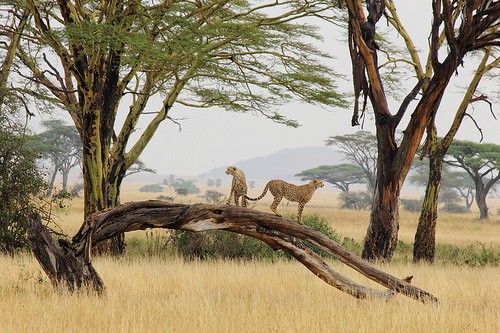Serengeti National Park is a wildlife reserve in the Mara and Simiyu regions of Tanzania, Africa. Famous for the annual migration of millions of wildebeests and zebra and Nile crocodiles, Serengeti has been conferred the status of a World Heritage Site by UNESCO.
Overview
Serengeti’s ecosystem is known to be one of the oldest on earth. The essential feature is that the climate, vegetation and fauna have barely changed in the past million years. It is believed that early man himself made an appearance in Olduvai Gorge about two million years ago and some patterns of life, death, adaptation and migration are as old as the hills themselves.
Serengeti is particularly famous for migratory birds and animals. Over a million wildebeest and about 200,000 zebras flow south from the northern hills to the southern plains for the short rains every October and November, and then swirl west and north after the long rains in April, May and June. This behaviour has been noticed since the ancient times and no drought, gorge or crocodile infested river has ever hold them back.
South Serengeti – Lake Lagarja/Lake Masak
Season: December to May
Depending on the rains, there are large animal herds concentrated on the low lying grass steppe between Olduvai, Gol, Naabi and Lagarja. Tourists can base on Lake Masak or Lake Lagarja and then travel from in all directions to little known areas to enjoy peace in an animal paradise. Places like the Hidden Valley, the Soito Ngum Kopjes or the Kakesio Plains are enjoyable. Here, one can enjoy the freedom of travelling cross country to be able to find the best places and have the chance to see rarer animals like honey-badgers, wild cats, porcupines and even Southern Serengeti(if you are lucky).
Central Serengeti – Moru Kopjes and Seronera
This area is famous for the savanna animals along with species that have adapted to living in the rocky cliffs. You can visit Seronera in the centre of the park where you can site rare leopards and cheetahs. You can throughly enjoy the ever changing landscape from gallery forests, kopjes to water holes.
North Serengeti – Lobo
North is much different than the grassy South. Animal herds retreat to the north in the dry season due to the abundance of water. Additionally there are many species like elephants can be found around the year. Bologonja Springs is a must visit place on the border to Kenya.
West Serengeti – The ‘Corridor’
Safari tours seldom cover West Serengeti. Long distances, poor communications (few vehicles are equipped with a radio) and the frequently difficult road conditions keep away most visitors from this part of the Serengeti which stretches almost as far as Lake Victoria.
This area is very different from the other main zones of the park. In dry season long stretches of the westward route is empty of animals. However, last quarter of the route can be suited to be the home for thousands of animals around the year. Resident animals – Gnus and zebras do not join their migratory relatives to the north. Big herds of giraffes, buffalo, eland, topis, kongonis, impalas, waterbuck and Thompson’s gazelles can also be found in this regain. All the big cats and hyenas are also present in a good number.
End of May to August is the time when zebra and wildebeest migrate to the Western Serengeti. This is also the season for wildebeest. A special attraction(becoming quite famous), is the crocodile population of the Grumeti River. This is particularly large at Kirawira, where the river does not dry up. Apart from crocodiles, one can notice hippos as well as large varieties of birds. Lucky tourists can also spot Black and White Colobus monkey in the crowns of the trees.
The wooded savannahs of the Ndabaka plains one can feel at peace with the calm pools and mysterious “korongos”. Mbalageti Serengeti is also in the Western corridor and offers an unparalleled view over the vast plains due to its stellar location.


